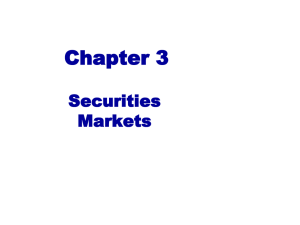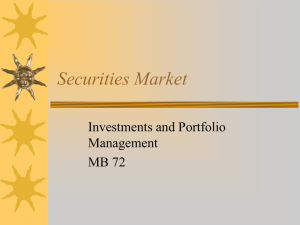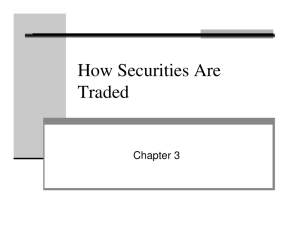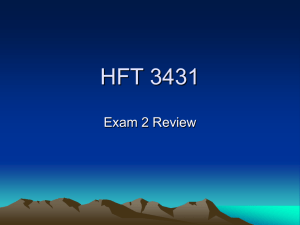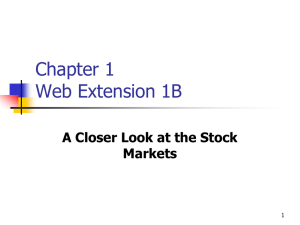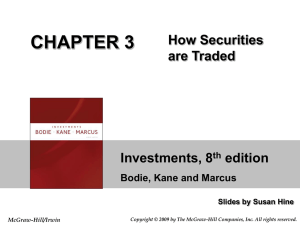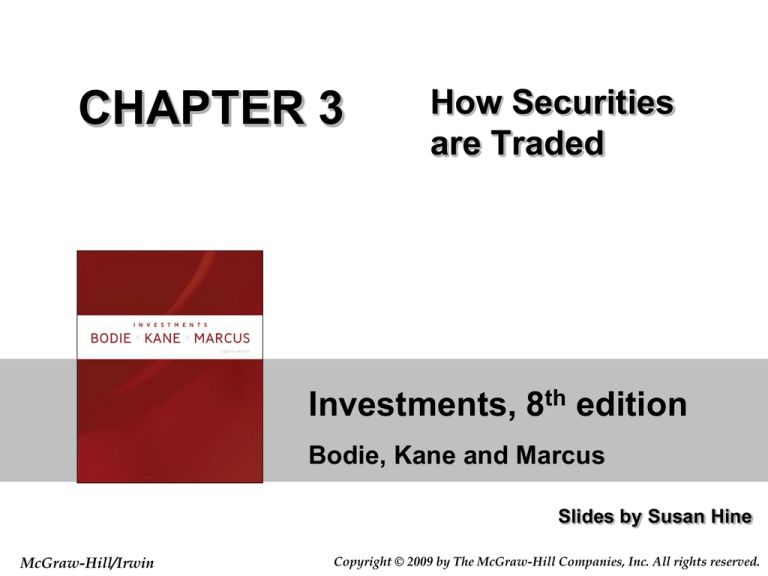
CHAPTER 3
How Securities
are Traded
Investments, 8th edition
Bodie, Kane and Marcus
Slides by Susan Hine
McGraw-Hill/Irwin
Copyright © 2009 by The McGraw-Hill Companies, Inc. All rights reserved.
Securities Markets
• Primary market: New issue
• Secondary market: Existing owner sells to
another party
• Initial Public Offerings
– Evidence of “underpricing”
– Subsequent underperformance
3-2
Types of Orders
• Market order (MO): buy or sell at the best
price now available
• Limit order (LO): buy or sell at the stated
price or better. Normally, a LO:
– To buy is below the market price
– To sell is above the market price
3-3
Example of Limit Order
• You own a stock that is trading at $50.
You are willing to buy more at a price of
$40 and you are willing to sell at a price of
$60.
• Enter a LO to buy @ $40.
• Enter a LO to sell @ $60.
• If the mkt price drops to $40, you will buy,
if it increases to $60, you will sell.
3-4
Types of Orders: Stop Order
• Stop (or stop loss) order:
– To sell is normally to close a long position and
price is below market.
– To buy is normally to cover a short position,
and price is above market.
3-5
Example of Stop Order
• You buy a stock when the price is $50.
You are not willing to lose more than $10
per share.
• Enter a stop loss order to sell @ $40. If the
mkt price drops to $40, it becomes a
market order and will be sold.
3-6
Order Size
•
•
•
•
Block trade: 10,000 share minimum
Round lot: 100 shares
Odd lot: less than 100 shares
Block trades account for about 20% of
shares traded; odd lot trades are less than
5%.
3-7
Trading Mechanisms
• Dealer markets (NASDAQ)
• Electronic communication networks (ECNs)
• Specialists markets (NYSE)
3-8
Trading Costs
• Commission: fee paid to broker for making
the transaction
• Spread: cost of trading with dealer
– Bid: price dealer will buy from you
– Ask: price dealer will sell to you
– Spread: ask - bid
• Combination: on some trades both are paid
3-9
Buying on Margin
• Investing on margin is purchasing
securities with borrowed funds.
• In margin transactions, margin refers to
the investor’s equity in the position.
3-10
Stock Margin Trading
• Margin is currently 50%; you can borrow up to
50% of the stock value
– Set by the FRS
• Maintenance margin: minimum amount equity
in trading can be before additional funds must
be put into the account
• Margin call: notification from broker that you
must put up additional funds
3-11
Short Sales
Purpose: to profit from a decline in the
price of a stock or security
Mechanics
• Borrow stock through a dealer
• Sell it and deposit proceeds and margin in
an account
• Closing out the position: buy the stock
and return to the party from which it was
borrowed
3-12


